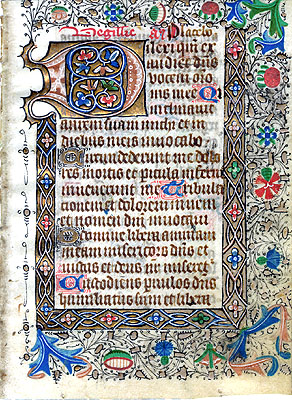 Medieval
Manuscripts were and are very beautifully decorated versions
of Latin, Greek, and usually Christian documents. Monks worked hard
to copy books by hand becuase the printing press had yet to be invented.
They did this with lots of embelishment, not becuase it was beautiful,
but because it was difficult and tedious work. This type of monotonous
work was intended to keep the monk's mind off of the worldly pleasures
and to keep his mind on the spiritual afterlife to come.
Medieval
Manuscripts were and are very beautifully decorated versions
of Latin, Greek, and usually Christian documents. Monks worked hard
to copy books by hand becuase the printing press had yet to be invented.
They did this with lots of embelishment, not becuase it was beautiful,
but because it was difficult and tedious work. This type of monotonous
work was intended to keep the monk's mind off of the worldly pleasures
and to keep his mind on the spiritual afterlife to come.
Many Monks
kept the candles burning far into the night as they slaved away at the
awesome task of copying books that we would barely be able to read ourselves.
The language is not the only barrier. The books were written on parchment
or on the dried skins of animals. The pens were nothing but brushes,
sticks or other crude and rudimentary implements that could be had.
The fountain, ball-point, or roller-ball pens of today would have medieval
monks sighing a breath of relief. Whoa, they better go and find something
harder and more difficult to do!
The Celtic
Influence in the copying of manuscripts (literally:
Hand-writing) is very apparent. Some of our best examples come from
the British Isles, and Ireland in particular. A famous book of Kells,
or so they are called, shows some of the finest handi-work ever created
in the monastery. These have survived and are treasured by historians,
but tedious to read and to understand. The picture on this page is
only one of the beautiful examples to be seen.
To See More Kells Click Below:
Kell #1
Kell #2
Kell #3
Kell #4
Kell #5
 Return
to Hompage
Return
to Hompage
 Medieval
Manuscripts were and are very beautifully decorated versions
of Latin, Greek, and usually Christian documents. Monks worked hard
to copy books by hand becuase the printing press had yet to be invented.
They did this with lots of embelishment, not becuase it was beautiful,
but because it was difficult and tedious work. This type of monotonous
work was intended to keep the monk's mind off of the worldly pleasures
and to keep his mind on the spiritual afterlife to come.
Medieval
Manuscripts were and are very beautifully decorated versions
of Latin, Greek, and usually Christian documents. Monks worked hard
to copy books by hand becuase the printing press had yet to be invented.
They did this with lots of embelishment, not becuase it was beautiful,
but because it was difficult and tedious work. This type of monotonous
work was intended to keep the monk's mind off of the worldly pleasures
and to keep his mind on the spiritual afterlife to come.
 Return
to Hompage
Return
to Hompage